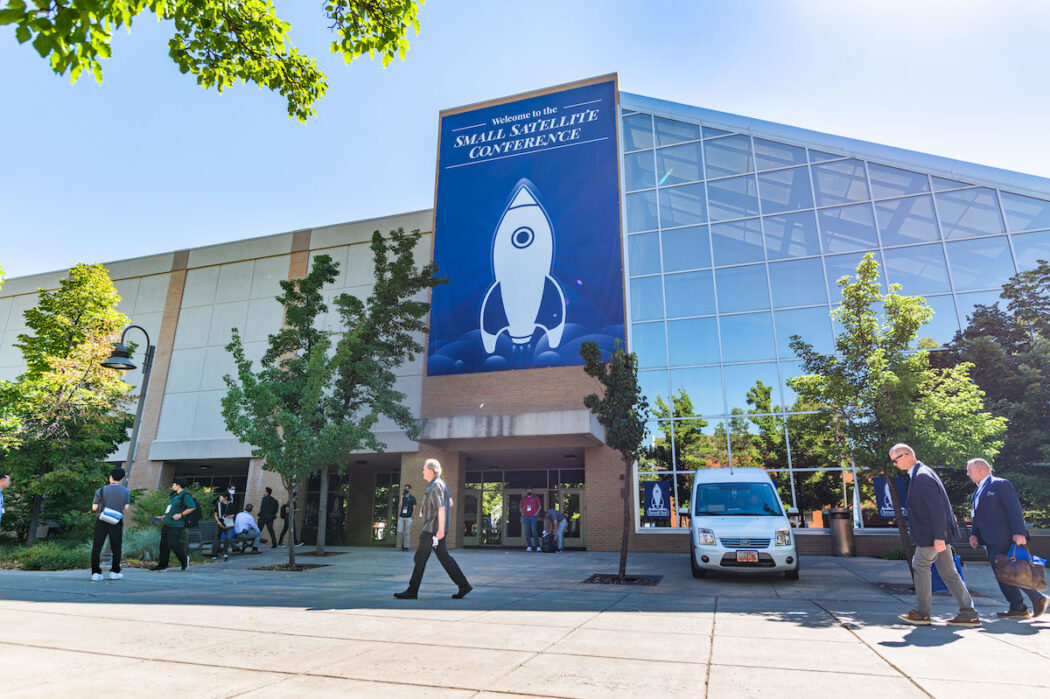Guest column: Small Satellite Conference is a welcoming experience into STEM
I’m an incoming freshman who plans to major in mathematics and I recently moved into an apartment in Logan, and as I started to explore my new town, I was curious about some light pole banners up and down Main Street advertising something called SmallSat.
After some light googling, I found that Utah State University hosts the annual Small Satellite Conference every year, casually referred to as SmallSat. They’ve been doing it for 36 years and if you walked through the Taggart Student Center from Aug. 6 to 11, you witnessed its transformation into a veritable space bazaar.
I felt the need to explore further the connection between my new school, for the next four years, and its connection with space. I knew USU offered a whole different world, and during SmallSat, I got a first-hand glimpse of it while attending the conference at USU.
As an unititated, industry experts explained to me that small satellites are spacecraft ranging in size from something you can fit in the palm of your hand, to the size of a Volkswagen Beetle. Traditionally, satellites have been much larger, sometimes the size of a school bus, much more expensive to make than smaller satellites, and with greater build times. Throughout the past decade, the small satellite market has seen an explosion in growth with the advancement of the minaturation of technology. And USU has been at the center of much of the research and development that has enabled such growth.
SmallSat 2022 returned this year after going virtual since COVID-19 hit, and it felt like a victory lap. According to the conference organizers at USU’s Space Dynamics Laboratory, 3,300 attendees from 40 countries representing 1,000 descended upon Logan and USU. 240 organizations from all parts of the small satellite industry – from deep-space radio manufacturers to rocket launch providers – set up booths that stretched from TSC into the Field House.
It was so inspiring to talk with other women in the STEM disciplines, with it being such a male-dominated section of science. These women gave encouraging advice on navigating my way into this field. There are so many fascinating projects happening in the small satellite world right now, everything from the Lunar Trailblazer missions from NASA to an inflatable space station from the Sierra Space Company. It is so refreshing to see so many new and innovative things happening in the world of science.
One of those amazing things will be NASA’s Sun Radio Interferometer Space Experiment, known as SunRISE. This experiment will be a constellation of six separate toaster-size satellites located in a graveyard orbit, so called because it’s the location in space where some satellites are pushed at the end of their operations lives to avoid colliding with operational spacecraft.
During a briefing, program managers from NASA and USU’s Space Dynamics Laboratory explained that the mission objective is to detect and study solar bursts, and create detailed 3D maps of where energetic radio emissions occur in the Sun’s magnetic atmosphere. SunRISE will be a very useful study to help protect the health of astronauts traveling in space and predict how these solar storms affect the technology on Earth as well. The fleet will be headed above the geosynchronous orbit, about 22,400 miles above Earth’s surface. The six separate small satellites will not fly in a tight formation but more spread apart acting as one giant radio telescope about 6.2 miles in diameter. The project team for this mission is very diverse, being led by the University of Michigan, managed by NASA’s Jet Propulsion Laboratory, and built at our very own Space Dynamics Laboratory on USU’s Innovation Campus – about three miles north of Old Main.
One of my favorite projects learned from this experience is from the Sierra Space Company. I was fascinated with their Dream Chaser mission; their vision is to “Enable humanity to begin new civilizations in space.” The first step to that is their Dream Chaser space-plane. It is a utility vehicle designed to transport a small crew of about 3-5 astronauts, including cargo, to a low-Earth orbiting station, such as the International Space Station. The space-plane will be the first of its kind to be a ‘vehicle’ for orbital space travel.
Sierra Space also plans to build the ‘LIFE Habitat’ (Large Integrated Flexible Environment) along with its Space-plane. Once launched into orbit, it will be inflated into a structure almost three stories tall with about 300 cubic meters of pressurized volume. The design can comfortably support four passengers with the additional room for experiments, a medical center, and an astro garden system that grows fresh produce for astronauts on long-term missions. Sierra’s mission really feels like the future and has provided inspiration for me to perhaps explore this field to one day work on something just as important to humanity.
As first impressions go for a new school, the entire experience has been inspiring and a huge driving force for me, speaking to the many companies and universities attending the SmallSat. Conversing with industry experts and them rooting for me, an incoming freshman, to succeed in the field wishing me the best, was a welcoming first experience into the field of STEM.
Lauren Marberger is a freshman at Utah State University planning to major in mathematics.

